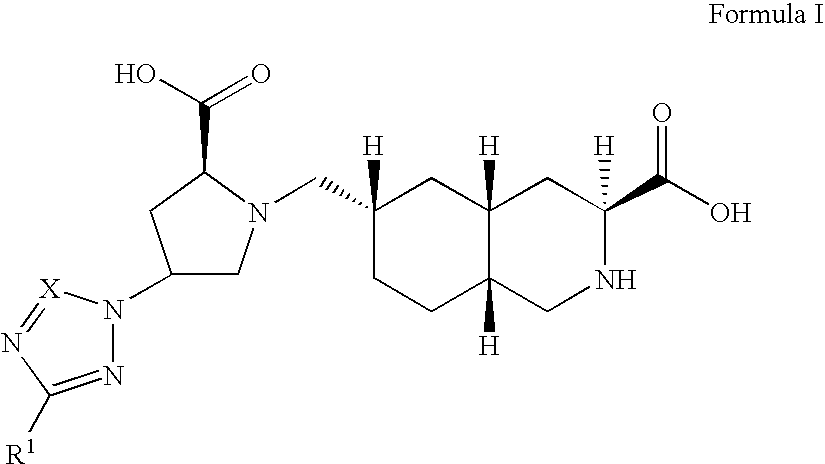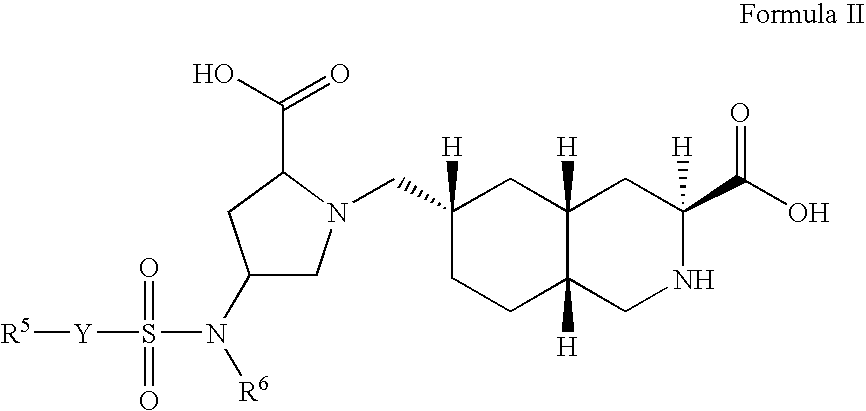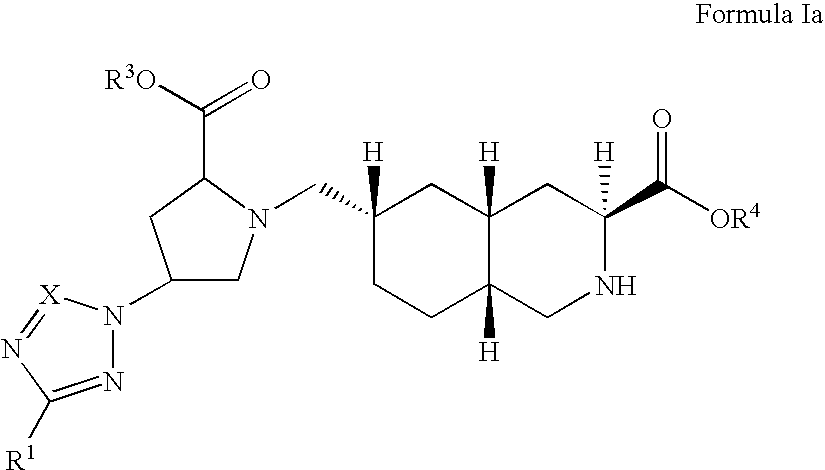Excitatory amino acid receptor antagonists
a technology of amino acid receptors and antagonists, which is applied in the direction of biocide, heterocyclic compound active ingredients, drug compositions, etc., can solve the problems of neuronal cell damage or loss, and achieve the effect of treating or preventing migrain
- Summary
- Abstract
- Description
- Claims
- Application Information
AI Technical Summary
Benefits of technology
Problems solved by technology
Method used
Image
Examples
preparation 1
3S,4aR,6S,8aR Ethyl 6-(((3S,5S)-5-(Ethoxycarbonyl)-3-hydroxypyrrolidinyl)methyl)-2-methoxycarbonyl-1,2,3,4,4a,5,6,7,8,8a-decahydroisoquinoline-3-carboxylate
A. Preparation of 3S,4aR,6S,8aR Ethyl 6-((4-Methylphenyl)sulfonyloxy)methyl)-2-methoxycarbonyl-1,2,3,4,4a,5,6,7,8,8a-decahydroisoquinoline-3-carboxylate
To a solution of 15.0 g (50.1 mmol) of Ethyl 6-hydroxymethyl-2-methoxycarbonyl-decahydroisoquinoline-3-carboxylate (See Col.11-12, Scheme II of U.S. Pat. No. 5,356,902, the entire contents of which are herein incorporated by reference) cooled to 0° C. in CH2Cl2 (100 mL), was added triethylamine (20.9 mL, 150.3 mmol) followed by toluenesolfonyl chloride (19.1 g, 100.2 mmol) dissolved in CH2Cl2 (100 mL). The reaction was warmed to room temperature and stirred 16 h, then partitioned between CH2Cl2 and 10% aqueous NaHSO4. The aqueous layer was extracted with CH2Cl2 and the combined organics were dried over MgSO4, filtered, and concentrated in vacuo. Column chromatography (10-50% EtOAc...
example 1
Preparation of (3S,4aR,6S,8aR)-6-[[(2S,4S)-2-carboxy-4-(tetrazol-1-yl)-1-pyrrolidinyl]methyl]decahydroisoquinoline-3-carboxylic acid dihydrochloride
A. Preparation of Ethyl 2-methoxycarbonyl-6-[[2-ethoxycarbonyl-4-(tetrazol-1-yl)-1-pyrrolidinyl]methyl]decahydroisoquinoline-3-carboxylate:
To a 0° C. solution of 0.50 g (1.1 mmol) of material from Preparation 1, 0.087 g (1.2 mmol) of tetrazole, and 0.33 g (1.2 mmol) of triphenylphosphine in 5 mL of dry tetrahydrofuran was added 0.22 g (1.2 mmol) of diethylazodicarboxylate dropwise. The mixture was stirred at room temperature for 18 hours, and then concentrated in vacuo. Chromatography on 25 g silica gel (35% ethyl acetate / toluene) followed by elution through a 5 g Varian Bond Elut® SCX column with 2M ammonia in methyl alcohol afforded 0.17 g (31%) of the title compound.
Positive ion electrospray mass spectrum: [M+H]+=493.
B. A solution of 0.17 g (0.3 mmol) of material from Example 1, step A in 5 mL of 6N hydrochloric acid was heated at 95°...
example 2
Preparation of (3S,4aR,6S,8aR)-6-[[(2S,4S)-2-carboxy-4-(5-methyltetrazol-2-yl)-1-pyrrolidinyl]methyl]-decahydroisoquinoline-3-carboxylic acid dihydrochloride
A. Preparation of Ethyl 2-methoxycarbonyl-6-[[2-ethoxycarbonyl-4-(5-methyltetrazol-2-yl)-1-pyrrolidinyl]methyl]decahydroisoquinoline-3-carboxylate:
To a 0° C. solution of 0.50 g (1.1 mmol) of material from Preparation 1, 0.10 g (1.2 mmol) of 5-methyltetrazole, and 0.33 g (1.2 mmol) of triphenylphosphine in 5 mL of dry tetrahydrofuran was added 0.22 g (1.2 mmol) of diethylazodicarboxylate dropwise. The mixture was stirred at room temperature for 18 hours, and then concentrated in vacuo. Elution through a 5 g Varian Bond Elut® SCX column with 2M ammonia in methyl alcohol followed by chromatography on 25 g silica gel (50% ethyl acetate / hexane) afforded 0.23 g (41%) of the title compound.
Positive ion electrospray mass spectrum: [M+H]+=507.
B. A solution of 0.23 g (0.45 mmol) of material from Example 2, step A in 5 mL of 6N hydrochlori...
PUM
| Property | Measurement | Unit |
|---|---|---|
| Electrical conductance | aaaaa | aaaaa |
| Electrical conductance | aaaaa | aaaaa |
| Disorder | aaaaa | aaaaa |
Abstract
Description
Claims
Application Information
 Login to View More
Login to View More - R&D
- Intellectual Property
- Life Sciences
- Materials
- Tech Scout
- Unparalleled Data Quality
- Higher Quality Content
- 60% Fewer Hallucinations
Browse by: Latest US Patents, China's latest patents, Technical Efficacy Thesaurus, Application Domain, Technology Topic, Popular Technical Reports.
© 2025 PatSnap. All rights reserved.Legal|Privacy policy|Modern Slavery Act Transparency Statement|Sitemap|About US| Contact US: help@patsnap.com



